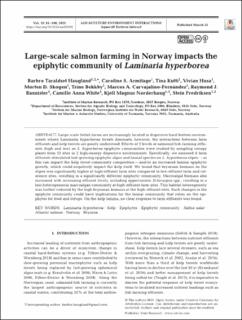| dc.contributor.author | Haugland, Barbro Taraldset | |
| dc.contributor.author | Armitage, Caroline S. | |
| dc.contributor.author | Kutti, Tina | |
| dc.contributor.author | Husa, Vivian | |
| dc.contributor.author | Skogen, Morten D. | |
| dc.contributor.author | Bekkby, Trine | |
| dc.contributor.author | Carvajalino-Fernandez, Marcos Antonio | |
| dc.contributor.author | Bannister, Raymond J | |
| dc.contributor.author | White, Camille Anna | |
| dc.contributor.author | Norderhaug, Kjell Magnus | |
| dc.contributor.author | Fredriksen, Stein | |
| dc.date.accessioned | 2021-07-14T07:15:54Z | |
| dc.date.available | 2021-07-14T07:15:54Z | |
| dc.date.created | 2021-02-09T12:19:49Z | |
| dc.date.issued | 2021 | |
| dc.identifier.citation | Aquaculture Environment Interactions. 2021, 13, 81-100. | en_US |
| dc.identifier.issn | 1869-215X | |
| dc.identifier.uri | https://hdl.handle.net/11250/2764336 | |
| dc.description.abstract | Large-scale finfish farms are increasingly located in dispersive hard-bottom environments where Laminaria hyperborea forests dominate; however, the interactions between farm effluents and kelp forests are poorly understood. Effects of 2 levels of salmonid fish-farming effluents (high and low) on L. hyperborea epiphytic communities were studied by sampling canopy plants from 12 sites in 2 high-energy dispersive environments. Specifically, we assessed if farm effluents stimulated fast-growing epiphytic algae and faunal species on L. hyperborea stipes—as this can impact the kelp forest community composition—and/or an increased lamina epiphytic growth, which could negatively impact the kelp itself. We found that bryozoan biomass on the stipes was significantly higher at high-effluent farm sites compared to low-effluent farm and reference sites, resulting in a significantly different epiphytic community. Macroalgal biomass also increased with increasing effluent levels, including opportunistic Ectocarpus spp., resulting in a less heterogeneous macroalgae community at high-effluent farm sites. This habitat heterogeneity was further reduced by the high bryozoan biomass at the high-effluent sites. Such changes in the epiphyte community could have implications for the faunal community that relies on the epiphytes for food and refuge. On the kelp lamina, no clear response to farm effluents was found. | en_US |
| dc.language.iso | eng | en_US |
| dc.publisher | Inter Research | en_US |
| dc.rights | Navngivelse 4.0 Internasjonal | * |
| dc.rights.uri | http://creativecommons.org/licenses/by/4.0/deed.no | * |
| dc.title | Large-scale salmon farming in Norway impacts the epiphytic community of Laminaria hyperborea | en_US |
| dc.type | Peer reviewed | en_US |
| dc.type | Journal article | en_US |
| dc.description.version | publishedVersion | en_US |
| dc.rights.holder | © The authors 2021 | en_US |
| dc.source.pagenumber | 81-100 | en_US |
| dc.source.volume | 13 | en_US |
| dc.source.journal | Aquaculture Environment Interactions | en_US |
| dc.identifier.doi | 10.3354/aei00392 | |
| dc.identifier.cristin | 1888074 | |
| dc.relation.project | Norges forskningsråd: 228871 | en_US |
| cristin.ispublished | true | |
| cristin.fulltext | original | |
| cristin.qualitycode | 1 | |

